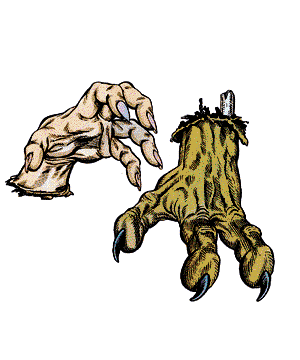

2140

| Climate/Terrain: | Any |
|---|---|
| Frequency: | Rare |
| Organization: | Swarm |
| Activity Cycle: | Any |
| Diet: | Special |
| Intelligence: | Non- (0) |
| Treasure: | Any |
| Alignment: | Neutral |
| No. Appearing: | 1-20 |
| Armor Class: | 7 |
| Movement: | 9 |
| Hit Dice: | 2-4 hit points |
| THAC0: | 20 |
| No. of Attacks: | 1 |
| Damage/Attack: | 1-4 (armored foes) 1-6 (unarmored foes) |
| Special Attacks: | Nil |
| Special Defenses: | See below |
| Magic Resistance: | See below |
| Size: | T (human hand) |
| Morale: | Fearless (19-20) |
| XP Value: | 35 |
The much feared crawling claw is frequently employed as a guardian by those mages and priests who have learned the secret of its creation.
No single description of a crawling claw is possible as they are not uniform in appearance. Since claws are the animated remains of hands or paws of living creatures, they are apt to be found in a wide variety of shapes and sizes.
Combat: When a claw detects a potential victim, it leaps to the attack. Although it may not appear to be capable of such a feat, its great strength enables it to do so. The maximum distance a claw can leap is 15 feet.
Once a claw lands on its victim, it attacks in one of two ways. If the victim is wearing metal armor, the claw delivers a powerful blow that inflicts 1d4 points of damage. Against those who are not armored (or only wearing leather) the claw can employ its great strength in a crushing grip. This manner of attack causes 1d6 points of damage.
In some cases, a claw may be instructed to attempt to strangle or gouge out the eyes of a victim. In any such case, the DM should consider all aspects of the situation and determine how much, if any, damage is done.
Claws are immune to any form of death magic or raise dead spells, although a resurrection spell renders them immobile for a number of turns equal to the level of the caster. Claws have the same resistance to charm, sleep, and hold spells that undead do, but claws are not subject to turning, control undead spells, or damage by holy water. Cold-based spells make claws brittle so that all rolls to damage them are increased by 1 point per die.
Edged weapons inflict only half damage on a claw; all magical weapons cause damage as if they were not enchanted in any way (although to hit bonuses still apply).
Habitat/Society: Crawling claws are nothing more than the animated hands and paws of once-living creatures. As such, they have no culture or society to speak of. Despite this, crawling claws do have a limited ability to communicate with each other. This takes the form of a basic telepathic link between all the claws of a single “batch”. Whenever one claw finds a victim, all of the others in the area who were made at the same time move in to help it.
In addition, claws that have been instructed to do so can act in concert with each other to move large objects. The DM should use five pounds per claw as a reasonable limit to the weight that can be moved.
Ecology: Crawling claws can be created by any mage or priest who has knowledge of the techniques required to do so. To begin with, the creator must assemble the severed limbs that are to animated. The maximum number of claws that can be created at any one time is equal to the level of the person enchanting them. The hands (or paws) can be either fresh, skeletal, or at any stage of decomposition in between.
Claws can be controlled in one of two ways: directly or via programming. The manner of a claw’s control must be specified when it is created and cannot be changed thereafter. All of the claws in a particular batch must be controlled in the same manner.
Programmed claws are given a single, brief instruction that they attempt to carry out to the best of their ability. The maximum length of the programming, in words, is 15 plus the level of the creator. This programming sets the conditions under which the claw attack. A sample command might be: Kill anyone except me who opens this chest.
Directly controlled claws are manipulated by the thoughts of their creator. The mental effort of controlling claws is quite tiring and cannot be maintained for more than three consecutive rounds without a one-round rest. Further, the range of such control is limited to 10 feet plus 5 feet per level of the creator. A person controlling claws cannot undertake spellcasting or any other activity. Injury to a controller does not break his control unless unconsciousness results. If direct control is broken for some reason, the claws continue to follow the last orders they were given.

◆ 337 ◆